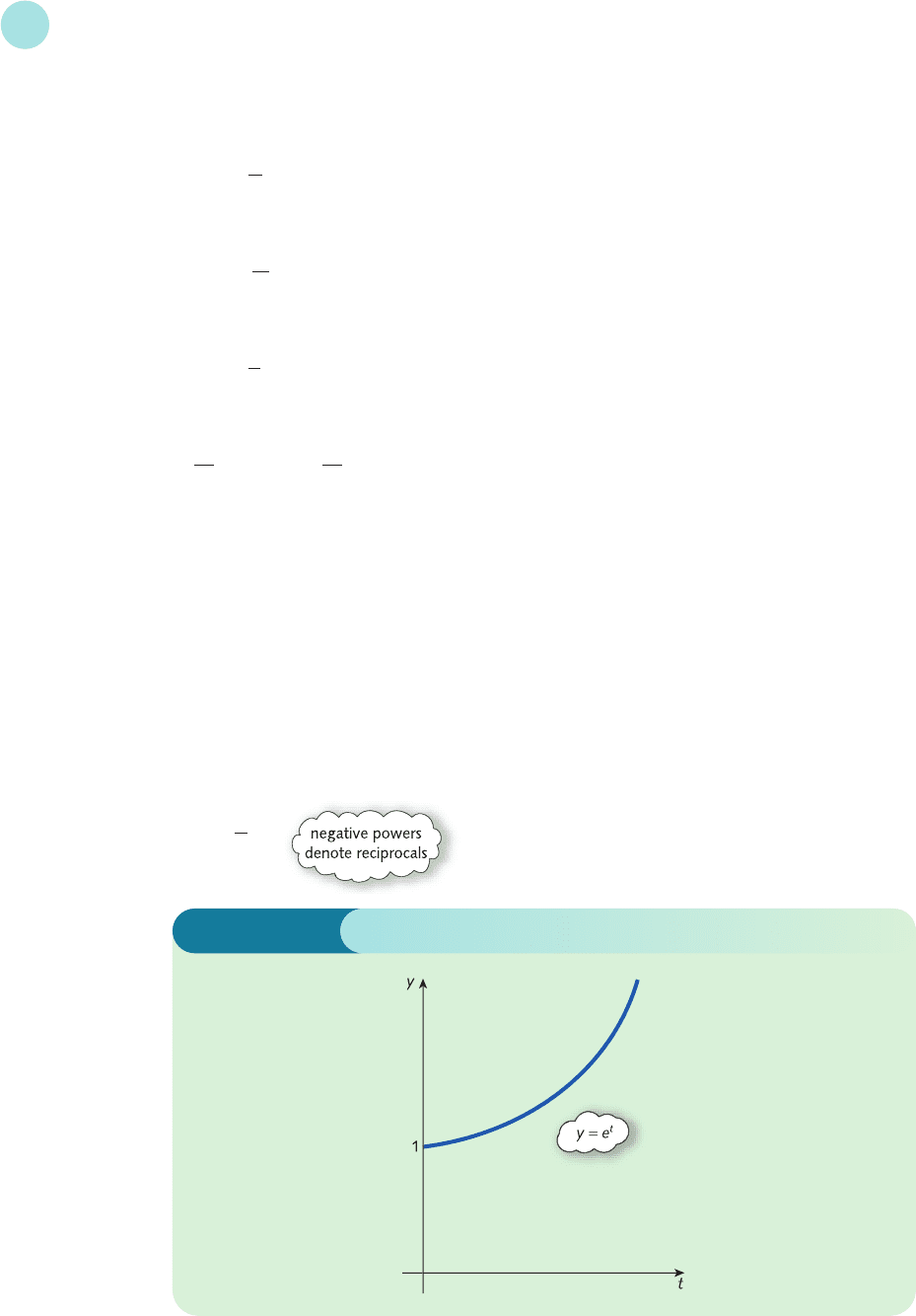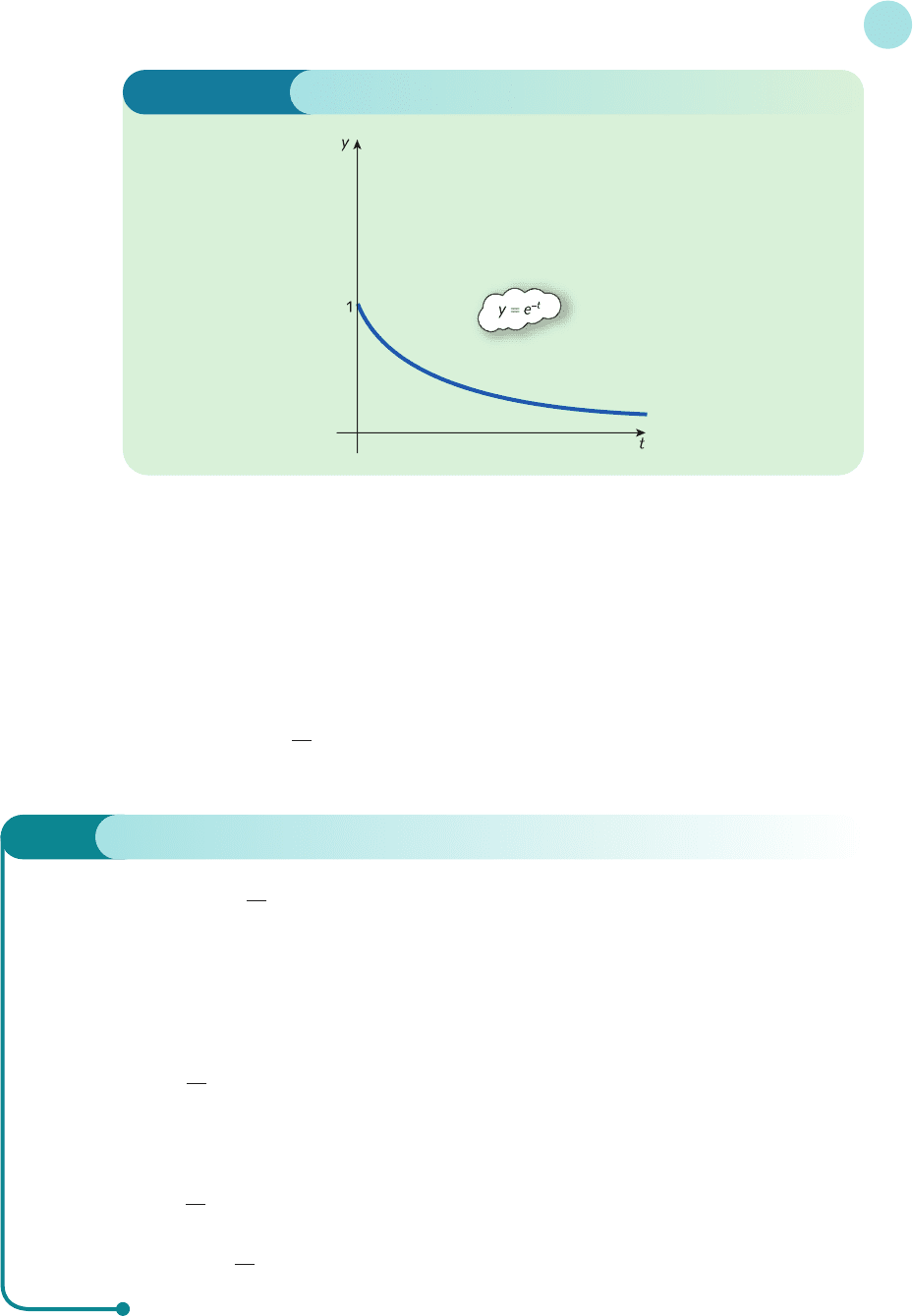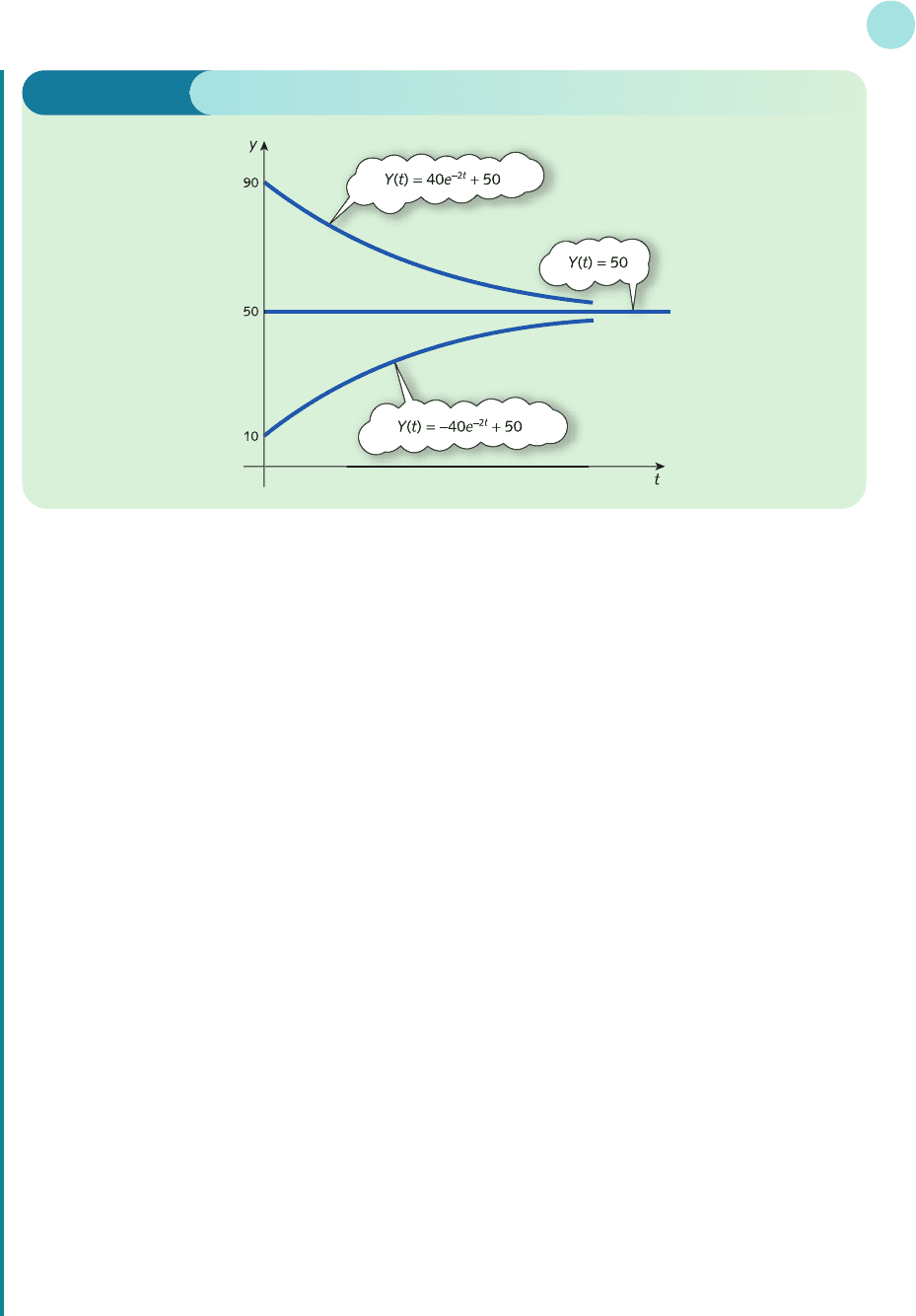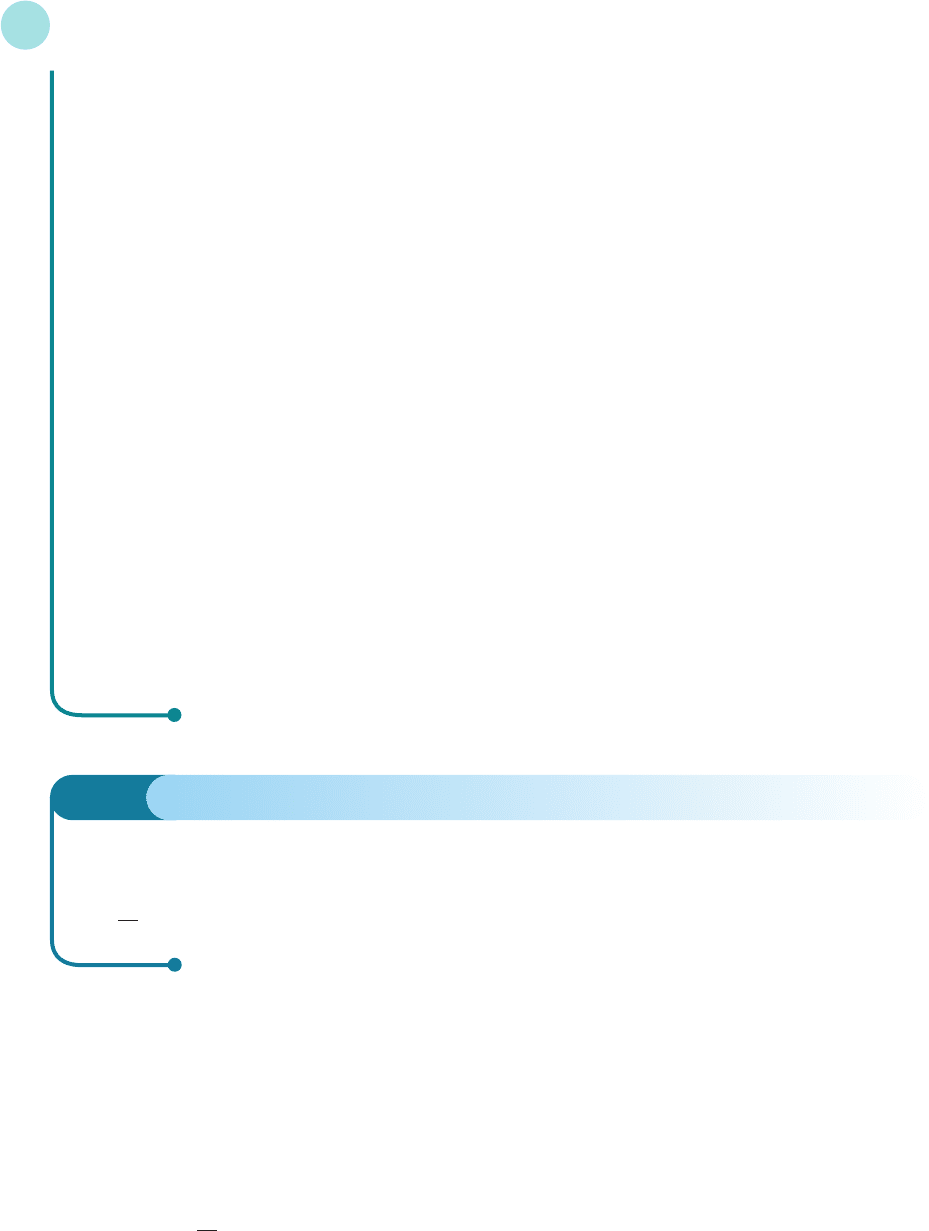Jacques I. Mathematics for Economics and Business
Подождите немного. Документ загружается.


is needed if the solution is to be pinned down uniquely. This is usually provided in the form of
an initial condition in which we specify the value of K at t = 0. For example, the capital stock
may be known to be 500 initially. Substituting t = 0 into the general solution
K(t) =+c
gives
K(0) =+c = 500
and so c is 500. Hence the solution is
K(t) =+500
In this section we investigate more complicated differential equations such as
= 5y and =−y + 3
The right-hand sides of these equations are given in terms of y rather than t and cannot be
solved by direct integration. It turns out that the solution of such equations involves the expon-
ential function, e
t
which was first introduced in Section 2.4. The letter e denotes the number
2.718 28...
and so e
t
simply means 2.718 28...raised to the power of t. A graph of e
t
against t is sketched
in Figure 9.5, which shows that e
t
grows rapidly with rising t. In fact, the basic shape is the same
for all exponential functions of the form
y = e
mt
when m is a positive constant. Figure 9.6 shows the graph of the negative exponential function,
e
−t
. The general behaviour of this function is to be expected because
e
−t
=
1
e
t
dy
dt
dy
dt
t
2
2
0
2
2
t
2
2
Dynamics
570
Figure 9.5
MFE_C09b.qxd 16/12/2005 10:49 Page 570

and, as t increases, the denominator increases, causing e
−t
to converge to zero. The basic shape
illustrated in Figure 9.6 is the same for all exponential functions of the form
y = e
mt
when m is a negative constant.
The most important property of the exponential function is that it differentiates to itself:
that is,
if y = e
t
then = e
t
dy
dt
9.2 • Differential equations
571
Figure 9.6
Example
Write down expressions for in the case when
(a) y = e
3t
(b) y = 7e
−4t
− 9
Solution
In Section 4.8 we showed that:
if y = e
mt
then = me
mt
so that e
mt
differentiates to m times itself.
Applying this result to
(a) y = e
3t
gives = 3e
3t
(b) y = 7e
−4t
− 9 gives =−28e
−4t
dy
dt
dy
dt
dy
dt
dy
dt
MFE_C09b.qxd 16/12/2005 10:49 Page 571

Dynamics
572
Practice Problem
1 Write down expressions for in the case when
(a)
y = e
5t
(b) y = 2e
−3t
(c) y = Ae
mt
dy
dt
Example
Find the solution of the differential equation
= 3y
which satisfies the initial condition, y(0) = 5.
Solution
The solution of the equation
= 3y
is any function, y(t), which differentiates to three times itself. We have noted that e
mt
differentiates to m
times itself, so an obvious candidate for the solution is
y = e
3t
However, there are many functions with the same property, including
y = 2e
3t
, y = 5e
3t
and y =−7.52e
3t
Indeed, any function of the form
y = Ae
3t
satisfies this differential equation because
= 3(Ae
3t
) = 3y
The precise value of the constant A is determined from the initial condition
y(0) = 5
If we substitute t = 0 into the general solution
y(t) = Ae
3t
we get
y(0) = Ae
0
= A
and so A is 5. The solution is
y(t) = 5e
3t
dy
dt
dy
dt
dy
dt
MFE_C09b.qxd 16/12/2005 10:49 Page 572

Consider the differential equation
= my + c (1)
where m and c are constants. The general solution of equation (1) is the sum of two separate
functions, known as the complementary function (CF) and particular solution (PS). These
are defined in much the same way as their counterparts for difference equations discussed in
the previous section. The complementary function is the solution of equation (1) when the
constant term on the right-hand side is replaced by zero. In other words, the complementary
function is the solution of
= my
The results of Practice Problem 2 show that this is given by
CF = Ae
mt
The particular solution is any solution that we are able to find of the original equation (1). This
can be done by ‘guesswork’, just as we did in Section 9.1. Finally, once CF and PS have been
determined, the general solution of equation (1) can be written down as
y = CF + PS = Ae
mt
+ PS
As usual, the specific value of A can be worked out at the very end of the calculations via an
initial condition.
dy
dt
dy
dt
9.2 • Differential equations
573
Practice Problem
2 (a) Find the solution of the differential equation
= 4y
which satisfies the initial condition, y(0) = 6.
(b) Find the solution of the differential equation
=−5y
which satisfies the initial condition, y(0) = 2.
dy
dt
dy
dt
Example
Solve the differential equation
=−2y + 100
in the case when the initial condition is
(a) y(0) = 10 (b) y(0) = 90 (c) y(0) = 50
Comment on the qualitative behaviour of the solution in each case.
dy
dt
MFE_C09b.qxd 16/12/2005 10:49 Page 573

Solution
The differential equation
=−2y + 100
is of the standard form
= my + c
and so can be solved using the complementary function and particular solution.
The complementary function is the general solution of the equation when the constant term is taken to
be zero: that is, it is the solution of
=−2y
which is Ae
−2t
. The particular solution is any solution of the original equation
=−2y + 100
that we are able to find. In effect, we need to think of a function, y(t), such that when it is substituted into
+ 2y
we obtain the constant value of 100. One obvious function likely to work is a constant function,
y(t) = D
for some constant D. If this is substituted into
=−2y + 100
we obtain
0 =−2D + 100
(Note that dy/dt = 0 because constants differentiate to zero.) This algebraic equation can be rearranged
to get
2D = 100
and so D = 50.
We have therefore shown that the complementary function is given by
CF = Ae
−2t
and that the particular solution is
PS = 50
Hence
y(t) = CF + PS = Ae
−2t
+ 50
This is the general solution of the differential equation
=−2y + 100
dy
dt
dy
dt
dy
dt
dy
dt
dy
dt
dy
dt
dy
dt
Dynamics
574
MFE_C09b.qxd 16/12/2005 10:49 Page 574

(a) To find the specific solution that satisfies the initial condition
y(0) = 10
we simply put t = 0 into the general solution to get
y(0) = Ae
0
+ 50 = 10
that is
A + 50 = 10
which gives
A =−40
The solution is
y(t) =−40e
−2t
+ 50
A graph of y against t is sketched as the bottom graph in Figure 9.7. This shows that y(t) increases from
its initial value of 10 and settles down at the value of 50 for sufficiently large t. As usual, this limit is
called the equilibrium value and is equal to the particular solution. The complementary function mea-
sures the deviation from the equilibrium.
(b) If the initial condition is
y(0) = 90
then we can substitute t = 0 into the general solution
y(t) = Ae
−2t
+ 50
to get
y(0) = Ae
0
+ 50 = 90
which has solution A = 40. Hence
y(t) = 40e
−2t
+ 50
9.2 • Differential equations
575
Figure 9.7
MFE_C09b.qxd 16/12/2005 10:49 Page 575

A graph of y against t is sketched as the top curve in Figure 9.7. In this case y(t) decreases from its
initial value of 90 but again settles down at the equilibrium level of 50.
(c) If the initial condition is
y(0) = 50
then we can substitute t = 0 into the general solution
y(t) = Ae
−2t
+ 50
to get
y(0) = Ae
0
+ 50 = 50
which has solution A = 0. Hence
y(t) = 50
A graph of y against t is sketched as the horizontal line in Figure 9.7. In this case y is initially equal to
the equilibrium value and y remains at this constant value for all time.
Notice that the solution y(t) eventually settles down at the equilibrium value irrespective of the
initial conditions. This is because the coefficient of t in the expression
CF = Ae
−2t
is negative, causing CF to converge to zero as t increases. We would expect convergence to occur for any
solution
y(t) = Ae
mt
+ D
when m < 0.
Dynamics
576
Practice Problem
3 Solve the following differential equation subject to the given initial condition. Comment on the qualita-
tive behaviour of the solution as t increases.
= 3y − 60; y(0) = 30
dy
dt
The results of the previous example and Practice Problem 3 can be summarized as:
if m < 0 then y(t) converges
if m > 0 then y(t) diverges.
We say that an economic model is stable whenever the variables converge as t increases.
The above results indicate that an economic system represented by
= my + c
is stable if the coefficient of y is negative and unstable if it is positive. Of course, it could
happen that m is zero. The differential equation then becomes
dy
dt
MFE_C09b.qxd 16/12/2005 10:49 Page 576

= c
which can be integrated directly to get
y(t) =
cdt = ct + d
for some arbitrary constant d. The corresponding model is therefore unstable unless c is also
zero, in which case y(t) takes the constant value of d for all t.
We now investigate two applications of differential equations taken from macroeconomics
and microeconomics respectively:
national income determination
supply and demand analysis.
We consider each of these in turn.
9.2.1 National income determination
The defining equations of the usual two-sector model are
Y = C + I (1)
C = aY + b (2)
I = I* (3)
The first of these is simply a statement that the economy is already in balance. The left-hand
side of equation (1) is the flow of money from firms to households given as payment for the
factors of production. The right-hand side is the total flow of money received by firms, either
in the form of investment, or as payment for goods bought by households. In practice, the
equilibrium values are not immediately attained and we need to make an alternative assump-
tion about how national income varies with time. It seems reasonable to suppose that the rate
of change of Y is proportional to the excess expenditure, C + I − Y: that is,
=α(C + I − Y ) (1′)
for some positive adjustment coefficient, α. This makes sense because
if C + I > Y, it gives dY/dt > 0 and so Y rises in order to achieve a balance between expendi-
ture and income
if C + I = Y, it gives dY/dt = 0 and so Y is held constant at the equilibrium level
if C + I < Y, it gives dY/dt < 0 and so Y falls in order to achieve a balance between expendi-
ture and income.
The usual relations (2) and (3) can be substituted into the new equation (1′) to obtain
=α(aY + b + I* − Y )
=α(a − 1)Y +α(b + I*)
which we recognize as a differential equation of the standard form given in this section.
dY
dt
dY
dt
dy
dt
9.2 • Differential equations
577
MFE_C09b.qxd 16/12/2005 10:49 Page 577

Dynamics
578
Example
Consider the two-sector model
= 0.5(C + I − Y )
C = 0.8Y + 400
I = 600
Find an expression for Y(t) when Y(0) = 7000. Is this system stable or unstable?
Solution
Substituting the expressions for C and I into
= 0.5(C + I − Y )
gives
= 0.5(0.8Y + 400 + 600 − Y )
=−0.1Y + 500
The complementary function is given by
CF = Ae
−0.1t
and for a particular solution we try
Y(t) = D
for some constant, D. Substituting this into the differential equation gives
0 =−0.1D + 500
which has solution D = 5000. The general solution is therefore
Y(t) = Ae
−0.1t
+ 5000
The initial condition
Y(0) = 7000
gives
A + 5000 = 7000
and so A is 2000. The solution is
Y(t) = 2000e
−0.1t
+ 5000
The first term is a negative exponential, so it converges to zero as t increases. Consequently, Y(t) eventually
settles down to an equilibrium value of 5000 and the system is stable.
dY
dt
dY
dt
dY
dt
MFE_C09b.qxd 16/12/2005 10:49 Page 578

In the previous example and again in Practice Problem 4 we noted that the macroeconomic
system is stable. If we return to the general equation
=α(a − 1)Y +α(b + I*)
it is easy to see that this is always the case for the simple two-sector model, since the coefficient
of Y is negative. This follows because, as previously stated, α>0 and because the marginal
propensity to consume, a, is less than 1.
9.2.2 Supply and demand analysis
The equations defining the usual linear single-commodity market model are
Q
S
= aP − b (1)
Q
D
=−cP + d (2)
for some positive constants a, b, c and d. As in Section 9.1, we have written Q in terms of P for
convenience. Previously, we have calculated the equilibrium price and quantity simply by
equating supply and demand: that is, by putting
Q
S
= Q
D
In writing down this relation, we are implicitly assuming that equilibrium is immediately
attained and, in doing so, we fail to take into account the way in which this is achieved. A
reasonable assumption to make is that the rate of change of price is proportional to excess
demand, Q
D
− Q
S
: that is,
=α(Q
D
− Q
S
) (3)
for some positive adjustment coefficient, α. This makes sense because
if Q
D
> Q
S
it gives dP/dt > 0 and so P increases in order to achieve a balance between supply
and demand
if Q
S
= Q
D
it gives dP/dt = 0 and so P is held constant at the equilibrium level
if Q
D
< Q
S
it gives dP/dt < 0 and so P decreases in order to achieve a balance between supply
and demand.
Substituting equations (1) and (2) into equation (3) gives
=α[(−cP + d) − (aP − b)] =−α(a + c)P +α(d + b)
which is a differential equation of the standard form.
dP
dt
dP
dt
dY
dt
9.2 • Differential equations
579
Practice Problem
4 Consider the two-sector model
= 0.1(C + I − Y )
C = 0.9Y + 100
I = 300
Find an expression for Y(t) when Y(0) = 2000. Is this system stable or unstable?
dY
dt
MFE_C09b.qxd 16/12/2005 10:49 Page 579
